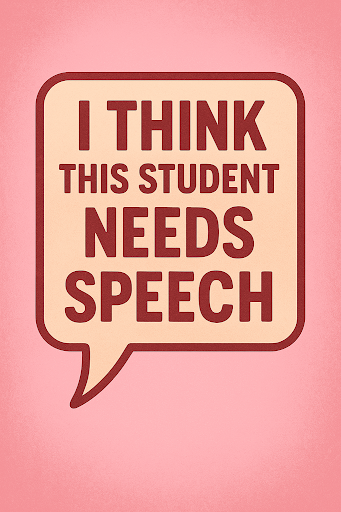How to Handle When a Teacher Says I Think This Student Needs Speech
Navigate referrals with professional boundaries and collaborative systems

You're walking through the hallway between sessions when a teacher stops you:
"Hey, can you listen to one of my students real quick? I think they need speech."
Cue the internal eye-roll. Not because you don't care — you do — but because this exact moment is where so many school SLPs feel stuck.
You want to be collaborative. You want to help kids. But you're also not a drive-thru diagnostician, and you know that "needing speech" means a lot of different things to different people.
Here's how to handle these moments with clarity, professionalism, and systems that protect your time and uphold best practice.
Why This Happens So Often
Teachers are on the front lines. They notice when students:
- Don't follow directions
- Speak unclearly
- Seem behind in class discussions
- Use simple or immature vocabulary
- Struggle socially
But they don't always know what qualifies as a true speech-language impairment — or what the legal requirements are for evaluation under IDEA.
To them, "Can you listen?" feels like a helpful heads-up. To you, it may feel like a fast-track to over-referral, burnout, and pressure to do more than your role allows.
Step 1: Slow It Down, Kindly
Instead of jumping into a quick screen, thank the teacher and gently set a boundary:
"Thanks for bringing that up — I definitely want to make sure the student is getting what they need. Let's take a minute to talk through what you're seeing."
This redirects the ask from an on-the-spot "check" to a collaborative conversation.
Step 2: Gather More Detail
Ask:
- What specifically are you noticing?
- In what context does it happen?
- Is it affecting academics or participation?
- Have parents mentioned any concerns?
This helps you differentiate between:
- Typical variation in language development
- A potential underlying disorder
- A mismatch between classroom demands and the student's current skills
Step 3: Know What's Required Before You Can Evaluate
Under IDEA and most district policies, you need:
- Documentation of concerns
- Evidence that the issue affects academic access
- Parental consent for evaluation
- A team decision — not just one request
If there's no clear educational impact, a full evaluation may not be appropriate. But that doesn't mean you do nothing.
Step 4: Offer Supportive Alternatives
If it's not referral-worthy yet, here's what you can offer:
- Classroom strategies: Visual cues, sentence frames, modeling
- Observation: With parent permission, you can observe and gather informal data
- In-class support ideas: Tools to help comprehension, expression, or social interaction
- Pre-referral documentation forms: Help teachers track specific concerns over time
Some districts have a tiered intervention process (like RTI or MTSS) that allows for this kind of support before a formal referral.
Step 5: Collaborate, Don't Gatekeep
Your role isn't to shut referrals down — it's to guide them through the right process.
Reframing goes a long way:
"If we collect some examples over the next couple weeks, I can help the team decide if this meets the criteria for a full evaluation. That way we're doing what's best for the student and following district policy."
Step 6: Create Systems That Save You Later
Rather than handling each teacher inquiry ad hoc, try:
- Creating a referral flowchart to share with your staff
- Holding "Speech Q&A" office hours once a month
- Building a short Google Form for pre-referral concerns
- Hosting a PD session on language red flags vs. classroom-based issues
The clearer the system, the fewer hallway surprises.
How SLP Score Can Help
When a referral does become a full evaluation, SLP Score makes sure you don't waste time on the writing.
With one tool, you can:
- Auto-score the most common assessments
- Generate compliant, narrative reports fast
- Customize recommendations and goals
- Export to Word or Google Docs
So when you do say "yes" to that referral, it doesn't derail your whole week.
You can't say yes to every ask. But when you do, let SLP Score handle the heavy lifting. Start here →
Ready to Streamline Your Referral Process?
SLP Score can help you handle evaluations efficiently when they do come through.
Try SLP Score Free